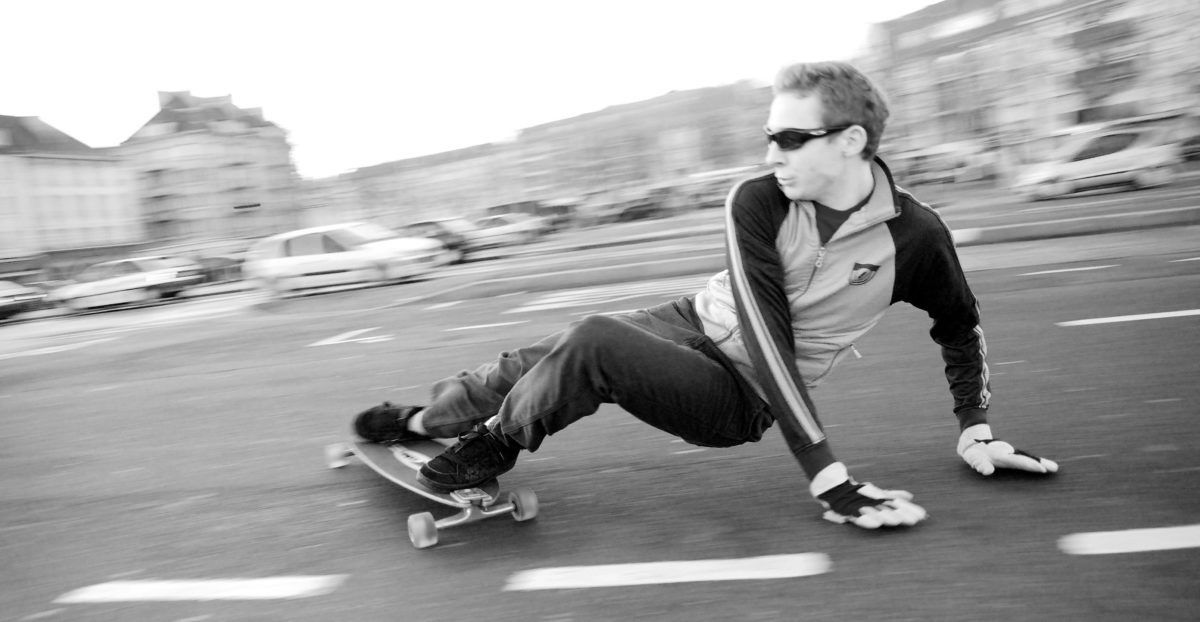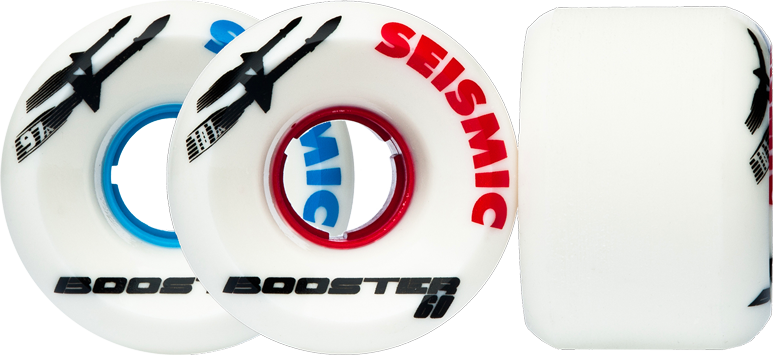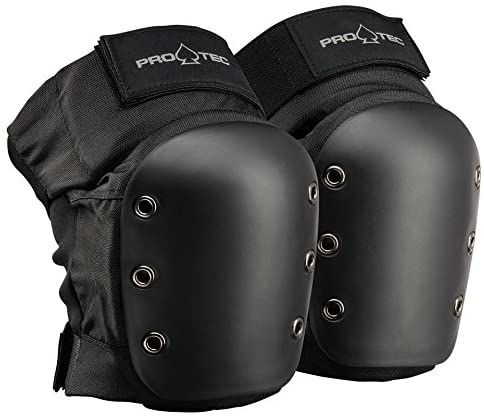Tech sliding, also referred to as techslide, tech-slide or technical sliding, is a discipline of downhill skateboarding where riders typically use hard wheels to bust out multiple fast paced and creative slides. This is a beginner’s guide to tech sliding and is equally suited to both new and experienced skaters alike!
Tech slide is like a hybrid discipline between street skating and freeride because most tech sliders use a regular Popsicle deck and normal hard wheels such as Spitfires, but hold out long slides like freeriders.
With tech slide, riders can do slide tricks such as 360s, rollercoasters, bluntslides, one footed slides, long and drawn out laybacks and anything else they can think of – all in the same run! In this beginner’s guide to tech sliding, we’ll cover equipment and techniques.
This discipline is only limited by the rider’s creativity. The use of hard wheels (typically 95a-101a) opens up the possibility of doing all these complex slides on smaller hills, with less speed and in quicker succession because there is less resistance to initiate the slide and keep it going for longer.
You might even see tech sliders using their kneepads and helmets in slides! Sergio Yuppie is famous for his headslides (picture below) and many riders take inspiration from him. His son Fernando is also an incredible rider and can hold out 50+ foot bluntslides without a problem (or a flatspot).
For me, techsliding was a way to leverage what was available around me. I live in a city where there aren’t a lot of steep, long hills, so hard wheel sliding makes even the smallest of hills fun.
I have the perfect practice spot that’s an empty parking lot with a slight incline. I can only do 1 soft wheel slide in it, but with hard wheels, I can throw multiple slides and spins to keep things fun! You might find that tech sliding makes some of your same spots more interesting and fun!
Let’s talk about the equipment you’ll need to get started and the techniques to make it more fun in this beginner’s guide to tech sliding.
Gear for Tech Sliding
Decks for Tech Sliding
To get started with tech slide you’ll need the right gear. Typically, riders use double kick boards ranging from 8.5 to 9.5 inches wide and 31 to 36 inches long.

There are some boards out there that are wider/longer that are still suitable for tech slide, like the Rayne Homewrecker or Bustin YoFace BG DK. You can also use a single kicktail board too. There is no “right” tech slide setup. As long as it’s fun for you to skate and it makes you happy, go for it!

If you are on a tighter budget, try checking your local Facebook Marketplace or Craigslist for cheaper used popsicle boards. You can sometimes luck out and find an 8.5 or 8.75 inch deck for sale locally! Once you get into bluntslides your board won’t last as long because of razor tail so local markets can be your friend to get you back up and rolling in a pinch if you don’t want to wait to get a new deck online.
Trucks for Tech Sliding
As for trucks, traditional kingpin trucks (TKPs) are the way to go. Independent is always a great choice and a staple brand in the industry but many other manufacturers make solid trucks like Ace, Caliber and Paris.
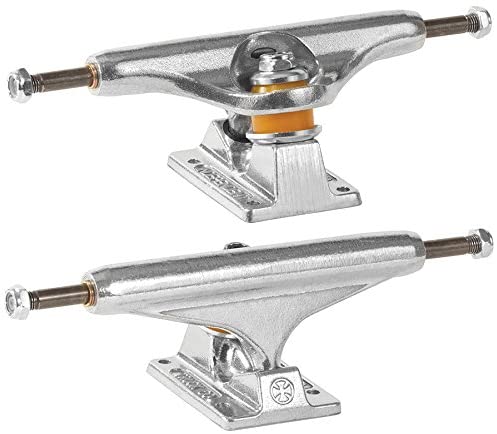
For 8.5 inch boards, trucks with a 149mm hanger are perfect, whereas for 8.75 you will need 159mm, and for boards nine inches and up you should consider 169mm hangers.
Independent makes all these widths and other brands, such as Caliber, make a 9 inch traditional kingpin truck. Paris makes a 169mm TKP that is a little taller than Independent’s if you’d like more clearance to run larger wheels!
If you’re interested in learning more about the differences between trucks, check out our truck guide here.
Read Our Longboard Truck Guide
Best Wheels for Tech Sliding
Just like longboarding there are a ton of tech slide wheel options out there. Generally you will want to stick to a harder wheel, 95a to 101a, for less resistance in your slides so you can do all the crazy tricks you see advanced tech sliders doing.
Spitfire Fromula Four wheels and Rainskates are highly flatspot resistant and provide a great slide, so they are a great beginner wheel.
Some longboard wheel companies are even getting into the hard wheel game too! Hawgs has their “Street Hawgs” which come in 99a and Seismic makes their “Boosters” in 99a and 101a.

Hawgs Street Hawgs 
Seismic Boosters
In terms of size, wheels 54mm and up are ideal because they provide a little bit of a smoother ride on rough surfaces. Keep in mind that you will be skating with hard wheels so no matter what, the ride will be rougher than soft wheels.
Your wheels will also wear faster with more frequent sliding, just like a soft wheel, so eventually they will wear down to 54mm. That’s okay, they will still be slidable to the core!
The takeaway here is that harder wheels are better for tech sliding!
Do You Need Pads for Tech Sliding?
We always advocate for safe skating and tech sliding is no exception. In many cases, you’re putting your body in positions that could increase the chance of pavement contact.
You’ll definitely need to use full protective gear to get started not only because of obvious safety reasons, but once you get more comfortable with sliding on hard wheels, you can start to incorporate your pads into slides.
Throwing a kneepad down on the ground during a heel side squat slide looks cool and adds some creativity to your runs!
We’re fans of TSG equipment and thankfully they produce products that suit tech-sliding well. If you’re looking for a more budget friendly option, Pro-Tec pads are also a good choice.
Technique for Tech Sliding
Making the switch from soft wheels to hard wheels will definitely feel different at first. One of the most common questions around hard wheel sliding is, “How do I slide hard wheels without icing out?”
When you slide with hard wheels the biggest thing to remember is that there will be dramatically less kickout and hookup when you start your slide. Because of that, in order to not ice out on every slide, you will have to lean back less to initiate your slide and stay more on top of your board during the slide.
The second you lean a little too far back in the slide you will ice out, just like when you have too much lean on a soft wheel slide and you end up icing out or going into an accidental heelside squat. However, with hard wheels, the icing out is more immediate than with a soft wheel. You will know right away if you are too far back because the board will ice out almost immediately.
The last tip for not icing out is to compensate for the slidier wheels by not kicking out as dramatically as you would with a soft wheel. If you kick out hard, like you are trying to get a 78a wheel to slide under 20 mph, you will end up with more pressure on your front foot which will cause the board to spin past 90 degrees, close to a 180.
Sometimes the extra momentum carried from the harder kickout will cause you to fall before the 180 rotation is completed.
How to learn to control hard wheels
When you first start sliding hard wheels, it’s a good idea to do a few glove down coleman slides to get an idea of what little resistance the wheels have.
Check this video for an example and a how-to of a coleman:
It’s best to keep speeds under 15mph when learning. You’ll find that there really is no resistance to the kickout and that you can pretty much slide forever. You’ll get used to this and gradually feel more comfortable with the motions of getting a hard wheel to slide.
Once you are feeling more comfortable with this, you can move to stand up slides.
There are some excellent examples of stand-up slides from Loaded in the following video:
Take them slow and don’t try to hold out 25 plus foot slides right off. Do little speed checks here and there to get used to hooking back up from the slide standing up. Once you are comfortable with speed checks, try to turn those into longer stand up slides and boom, you have officially learned how to control hard wheels!
How to not flatspot your wheels
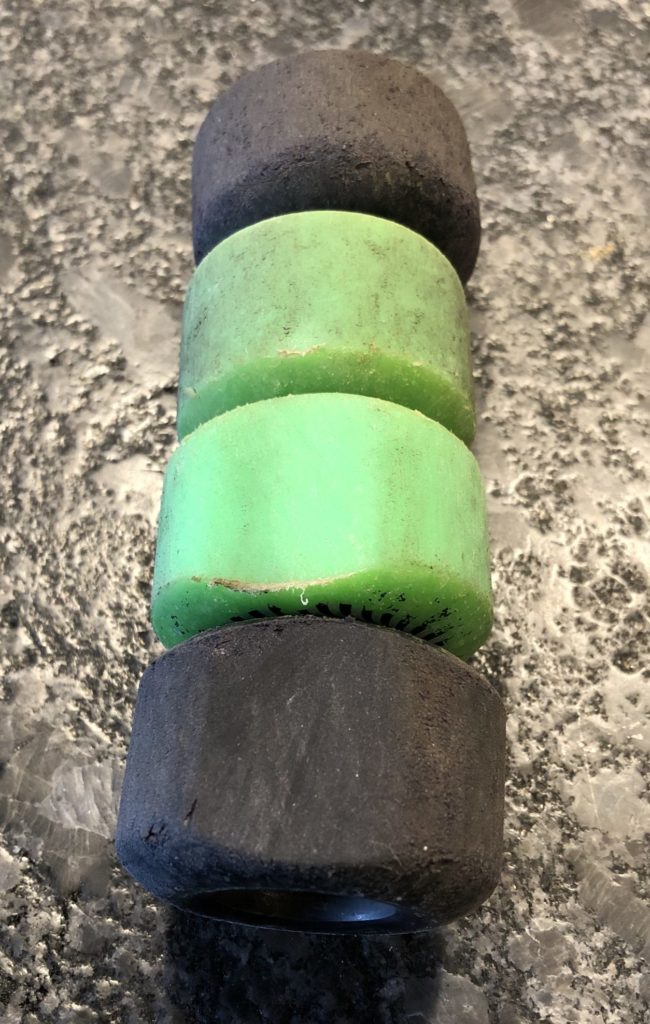
Flatspots are every skater’s worst enemy. Learning the basics of tech slide can definitely flatspot wheels so here are some tips to help prevent that.
Just like you see in almost every “how to slide” guide, try to avoid sliding 90 degrees as much as possible.
When sliding, try to keep your front foot angled a little to avoid going 90.
This can be tough with hard wheels since they are so touchy when sliding, but if you keep your slides below 90 degrees you shouldn’t have a problem with flatspots.
Also, carving into the slide, keeping your shoulders pointed downhill, and looking where you want to slide will help keep the board angled. If you open up your shoulders this will make you turn 90, or start the rotation of a 180.
Beginner Tech Slide Tricks
Now that you know the basics of how to control hard wheels, you can move on to trying some tricks out. The most basic trick is the coleman slide, which you will have already done to get used to the feeling of sliding hard wheels.
This coleman slide can then be turned into a one or two armed layback slide. These slides look very steezy when done right.
Other beginner tech slide tricks include one footed coleman slides, 180s, and glove down bluntslides. We will cover these tricks in a later guide.
That about sums up everything a rider who’s looking to get into tech sliding should know. Contact us with any questions and keep shredding!

